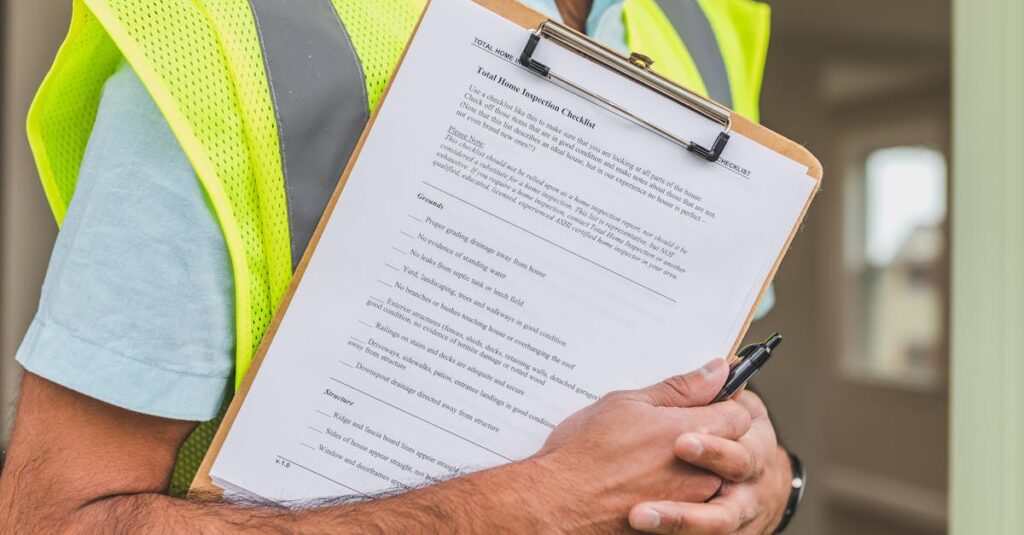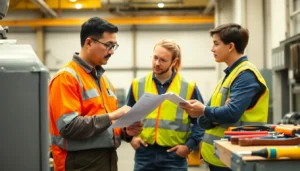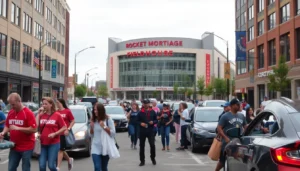Table of Contents
ToggleWhen it comes to home maintenance, the chimney often gets the cold shoulder. But ignoring it can lead to some fiery consequences—literally! A well-maintained chimney not only keeps your home cozy but also prevents dangerous situations like chimney fires or carbon monoxide leaks. So why not give your chimney the TLC it deserves?
This chimney maintenance checklist is your trusty sidekick in the battle against soot and creosote buildup. It’s time to don your superhero cape and tackle those tasks that’ll keep your chimney in tip-top shape. From inspecting for cracks to ensuring proper ventilation, this guide makes chimney care as easy as pie—without the smoke! So grab your favorite mug of cocoa and let’s dive into the essential steps to keep your chimney safe and sound.
Importance of Chimney Maintenance
Chimney maintenance plays a crucial role in ensuring home safety and efficiency. Regular upkeep reduces the risk of chimney fires, which can cause extensive damage. A well-maintained chimney also prevents carbon monoxide leaks, safeguarding the health of occupants.
Neglecting maintenance responsibilities can lead to serious hazards, making timely inspections essential. Homeowners should regularly check for cracks, blockages, and signs of wear. Proper ventilation within the chimney system promotes efficient operation and reduces the likelihood of dangerous buildup.
Additionally, routine cleaning removes soot and creosote accumulation, which significantly lowers fire risks. Understanding the importance of this maintenance helps homeowners prioritize essential tasks. Infrequent inspections can result in costly repairs or replacements, emphasizing the value of proactive care.
Deterioration may progress unnoticed, therefore regular assessments are vital for early detection of issues. Implementing a chimney maintenance checklist simplifies the upkeep process, making it easier for homeowners to stay on track. Prioritizing these tasks not only contributes to a safer living environment but also enhances the longevity of the chimney.
Over time, investment in chimney maintenance pays off through improved safety and efficiency. Homeowners can feel confident knowing they’re taking steps to protect their properties by adhering to maintenance guidelines.
Essential Tools for Chimney Maintenance
Effective chimney maintenance relies on the right tools. Homeowners should equip themselves with specific items to ensure proper cleaning and inspection.
Cleaning Tools
Chimney cleaning requires several important tools. A sturdy chimney brush effectively removes soot and creosote buildup. Brushes come in various sizes to fit different flues. A vacuum specifically designed for fireplace use helps collect debris, preventing mess during cleanup. Safety gear, including gloves and goggles, offers protection during the cleaning process. Additionally, a drop cloth protects floors and furniture from soot. Regular cleaning tools enhance safety and efficiency by minimizing fire hazards and improving airflow.
Inspection Tools
Chimney inspections demand precise tools. A flashlight illuminates dark areas, making it easier to identify cracks or obstructions. A digital camera captures images of hard-to-reach spots for later review. Chimney rods assist in maneuvering tools and brushes into narrow spaces. A moisture meter gauges the dampness of the chimney, helping determine if it requires repairs. Homeowners can ensure safety and functionality with these essential inspection tools, addressing potential issues before they escalate.
Seasonal Maintenance Tasks
Seasonal maintenance is crucial for ensuring that chimneys function safely and efficiently. Homeowners must perform specific tasks in both fall and spring to maintain their chimneys properly.
Fall Maintenance Checklist
Conducting a thorough inspection is essential before using the chimney in colder months. Check for any cracks or damage that may have formed during the summer. Clean the chimney flue to remove soot and creosote buildup, which poses a fire risk. Inspect the chimney cap for any loose parts, as this protects against rain and animals. Evaluating the flashing around the chimney helps prevent leaks. Lastly, ensure adequate ventilation, which supports optimal airflow and reduces harmful emissions.
Spring Maintenance Checklist
After a winter of heavy use, spring offers a chance to assess the chimney’s condition. Start with a comprehensive inspection for damage from the freezing temperatures and snow. Ensure that the chimney is clear of debris from storms or wildlife. Cleaning the flue remains vital, as it reduces the chances of dangerous buildup. Inspect the damper for proper operation, as it prevents drafts and improves energy efficiency. Lastly, schedule a professional inspection, which provides peace of mind regarding the chimney’s safety for the upcoming season.
Yearly Chimney Inspection
Yearly chimney inspections play a critical role in ensuring safe operation and efficiency. Scheduling an inspection allows individuals to address potential hazards before they escalate.
When to Schedule an Inspection
Homeowners should schedule an inspection at least once a year, ideally before the heating season begins. Autumn serves as the perfect time for this maintenance task. A pre-winter inspection allows identification of issues that could impact chimney performance during frequent use. Scheduling this inspection in early fall provides ample time for any needed repairs. For homes using wood-burning stoves, more frequent inspections might be necessary due to higher usage.
What to Expect During an Inspection
During an inspection, professionals thoroughly examine the chimney both inside and out. Expect assessments for structural integrity, creosote buildup, and blockages. Inspectors often check the flue for correct sizing and proper ventilation. Additionally, they examine the cap and flashing to prevent water intrusion. Homeowners might witness the use of specialized cameras to provide detailed views of hidden areas. Finally, inspectors offer recommendations for necessary repairs and maintenance, ensuring the chimney functions safely and efficiently.
Common Chimney Issues
Chimneys can develop a range of issues that homeowners need to address promptly. Recognizing these problems helps maintain safety and efficiency in the home.
Signs of Deterioration
Visible cracks in the chimney structure indicate potential structural concerns. A damaged chimney cap allows rain and debris to enter, heightening the risk of soot buildup. Soot and creosote accumulation often leads to blockages that can cause chimney fires. Staining on walls near the chimney suggests water damage, requiring immediate attention. An unusual odor or smoke escaping into the living space signals a problem that must be examined quickly.
Preventative Measures
Regular inspections catch issues early, preventing costly repairs later. Homeowners should clean the chimney flue at least once per year to minimize creosote buildup. Installing a chimney cap protects against water intrusion and animal nests. Sealing cracks in the masonry lowers the risk of leaks and further damage. Proper ventilation ensures optimal airflow, reducing the chance of smoke or harmful gases seeping into the home.
Conclusion
Prioritizing chimney maintenance is essential for every homeowner. By following the checklist and performing regular inspections and cleanings, they can significantly reduce risks associated with chimney fires and carbon monoxide leaks.
Taking proactive steps not only enhances safety but also improves the efficiency and longevity of the chimney system. Scheduling annual inspections and addressing any issues promptly ensures a reliable and safe fireplace experience.
Investing time and effort into chimney care pays off in peace of mind and a safer home environment.







